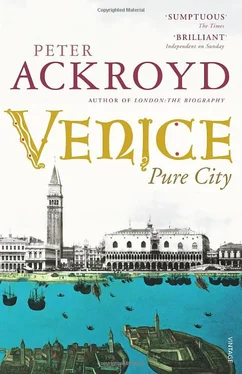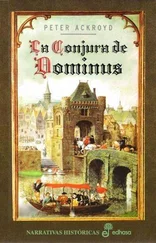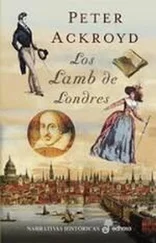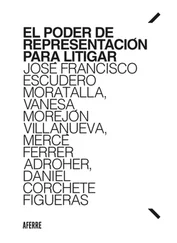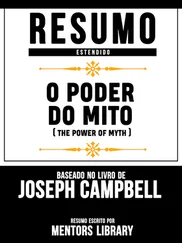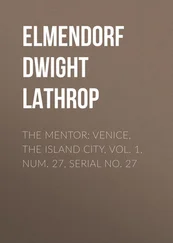For a city built upon water, water itself was sacred. It is what in the gospel of John is called “living water.” The well-heads themselves were highly decorated as a symbol of their significant content. They were embellished by fragments of altars, pieces of religious statuary, and the stones of ancient temples, as a token of their spiritual presence. There were accounts of miracles being performed by or beside the wells. In the plague of 1464 a monk was saved from extinction by a cup of water drawn for him by a knight from a local well. The knight was later identified as Saint Sebastian and, from that time forward, the pozzo became known as Saint Sebastian’s Well. Water is holy. The Byzantine well-heads were sculpted with a range of religious symbols, including the cross and the palm tree; they were cylinders of marble, that might have been glimpsed in any eastern city. The Gothic wellheads, which resembled the capitals of great pillars, displayed figures both naturalistic and grotesque. Yet the wells often ran dry. Venice, on water, was often in need of water. After storms the wells were marred by salt water. It was a general practice for boats to be despatched to the rivers Bottenigo and Brenta in order to pick up fresh supplies. Towards the end of the nineteenth century artesian wells were established on the mainland to guarantee a more bounteous flow.
Water was the staple of life, and so the wells became central to the social routine of each parish. The iron lid that closed the mouth of each well was opened at eight in the morning, so there were always knots of people beside it during the day. It is the most common view in photographs of “old” Venice. The well defined the intimacy and density of the parish. Water has always been the great unifier and leveller, and in many respects Venice was considered to be an egalitarian city. The well was a symbol of public beneficence, a visible token of the wise stewardship of the city.
But of course water is the life and breath of Venice’s being in quite another sense. Venice is like a hydropic body filled with water, where each part is penetrated by another. Water is the sole means of public transport. It is a miracle of fluid life. Everything in Venice is to be seen in relation to its watery form. The water enters the life of the people. They are “fluid”; they seem to resist clarity and precision. When the more affluent Venetians built villas on the mainland, they always chose sites as close as possible to the River Brenta. The Venetian painter, Tintoretto, loved to depict flowing and gushing water; it expressed something of his own spirit. In the work of Giorgione, and of his Venetian school, there are constant allusions to fresh and running water, to wells and pools and lakes. In myth and folklore water has always been associated with eyes, and with the healing of eyes. Is it any wonder, then, that Venice is the most visually seductive of all the cities of the world?
The endless presence of water also breeds anxiety. Water is unsettling. You must be more alert and watchful in your perambulations. Everything shifts. There is a sense of otherness. The often black or viscous dark green water looks cold. It cannot be drunk. It is shapeless. It has depth but no mass. As the Venetian proverb states, “water carries no stains.” This formless water has therefore been used as a metaphor for the human unconscious. In his essay, “The Visions of Zosimos,” Carl Jung relates that the spirit is hidden in water like the fish. Venice has been depicted as a fish. This wondrous water, infused with spirit, represents the cycle of birth and death. But if water is the image of the unconscious life, it thereby harbours strange visions and desires. The close affiliation of Venice and water encourages sexual desire; it has been said to loosen the muscles, by human imitation of its flow, and to enervate the blood.
Yet Venice reflects upon its own reflection in the water. It has been locked in that deep gaze for many centuries. So there has been a continuing association between Venice and the mirror. It was the first city to manufacture mirrors on a commercial scale, and by the seventeenth century was fashioning the largest mirrors in the world. The plate glass for mirrors had been created by the end of the fifteenth century. Two of the greatest of all Venetian artists, Giovanni Bellini and Titian, painted young women in the act of gazing at themselves in a mirror. In both of the paintings there is a mirror poised behind the head, and one raised towards the face. The date of both paintings has been given as 1515, only eight years after the government of Venice licensed the making of mirrors on the island of Murano. The artists were publicising Venetian commodities or, rather, they shared the Venetian preoccupation with luxury goods. Yet at the same time they were contemplating in painterly terms the contrast between the true surface and the glassy surface, a duality of which they were well aware in the world all around them. The young woman might have been Venice herself, sitting and admiring rather pensively her own reflection.
The image in the mirror may in some sense be a guarantee of identity and of wholeness. The root of narcissism lies in anxiety, and the fear of fragmentation, which may be assuaged by the sight of the reflection. The Virgin Mary, in the Book of Wisdom, is lauded as “a spotless mirror of God”; Venice always associated itself with the Virgin. But of course the image in the mirror is a false self; it is hard, abstract and elusive. It has been said that the Venetians are always aware of the image of themselves. They were once masters of the display and the masquerade. They were always acting. One of the favourite pastimes of Venetian audiences in the eighteenth century was the use of opera glasses trained upon each other.
It is a place of doubleness, and perhaps therefore of duplicity and double standards. Travelling on the newly built railway Richard Wagner was intent upon “looking down from the causeway at the image of Venice rising reflected from the waters beneath,” when his companion “suddenly lost his hat out of the railway car window when leaning out in delight.” The reflection is delightful because it seems to be as substantial and as lively as that which is reflected. When you look down upon the water, Venice seems to have no foundations except for reflections. Only its reflections are visible. Venice and Venice’s image are inseparable.
In truth there are two cities, which exist only in the act of being seen.
There is in Venice an abiding attachment to the surface. It has become commonplace that in the city only the fronts of houses were worth embellishment or decoration. Most of the Gothic façades are simply that—screens that bear no relation to the organic structure of the buildings themselves. It is one of the strangest aspects of a city that in certain respects resembles an ornamental shell. The rich plaster and stucco may conceal decaying brickwork, and Ruskin speculated on the “duplicity” of Saint Mark’s where internal and external ornamentation were quite distinct. The city was built in brick but disguised by marble.
It seemed to matter not at all that behind the sumptuous façades the grand Venetian houses were often cold, dirty and uncomfortable. In similar fashion, among the owners of these houses, there was an outward show of prodigality combined with avarice and penny-pinching at home. That was the Venetian way. It was not at all usual to invite guests, for example, into the house itself; that inward space was confined to relatives and the most intimate friends. The English poet, Thomas Gray, remarked that in their domestic lives Venetians were “parsimonious to a degree of nastiness.”
Honour was important in Venetian society, as in others, but the mark of honour was what was known as bella figura; it might be interpreted as the art of keeping up appearances. One of the great engines of Venetian life was, and is still, the fear of criticism. Everything must be done according to form, and for the sake of form. That form may hide malfeasance and corruption, but it is important that it remains in place. It resembles the façade or screen of the Venetian house.
Читать дальше
